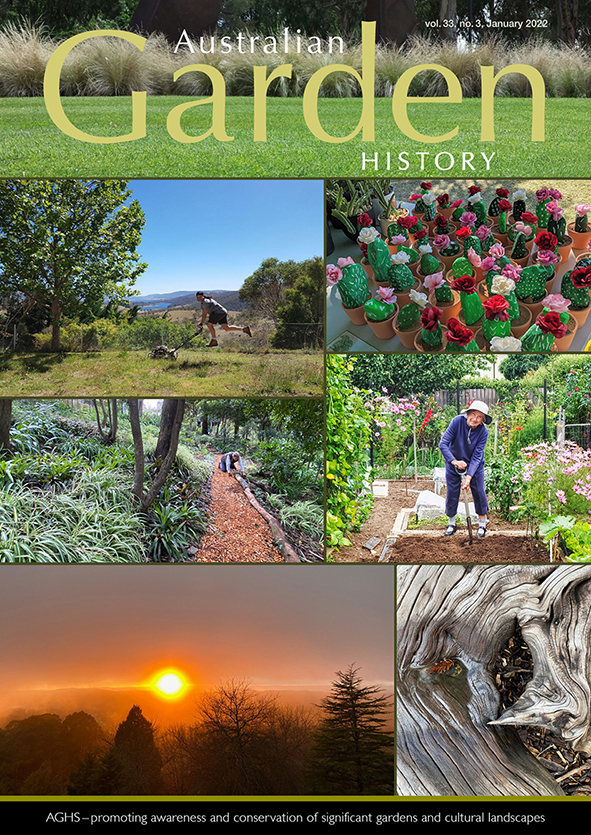Contents
Nourishing terrain: Gardens and colonisation of Australia Grace Karskens
The lost gardens of Sydney elicit sadness, nostalgia, even grief for the destruction of so much beauty and cultural heritage. The Aboriginal people who lost their Country to settlers and their gardens endure such grief too, though magnified, because their Country was not only beloved homeland and the source of law, culture and identity, but inspirited, sentient and alive.
Plants of the Simpson Desert: Introducing the collectors Rosemarie Purdie
The sand dunes of the Simpson Desert cover 130,000 square kilometres at the intersection of the Northern Territory (NT), Queensland (Qld) and South Australia (SA). Although European explorers first entered the Desert in the 1840s and 1860s, plant collectors only started visiting in the 1870s. The specimens they deposited in various Australian herbaria provide a history of the Desert’s plant collectors and collecting.
From 1879 to 1979 around 100 individuals gathered 3,556 specimens, although just 10 people were responsible for 66 per cent of the material. We know many of these people only by their name from a herbarium specimen. Even the prominent collectors have left behind few personal details; none appear to have written diaries detailing their activities.
A symbiosis of horticulture and painting: Exploring Henrietta Gulliver’s gardens through her art Beverley Ronalds
Henrietta Gulliver (1866–1945) is known for her paintings but was also an enthusiastic professional florist, horticulturist and landscape designer. She melded these skills through her life: her gardens provided subjects for her landscape paintings, her intimate understanding of their flowers enriched her still-life studies, and her floral arrangements brimmed with creative flair.
Gardens and flowers were also a central feature in Henrietta’s public activities. Her substantial portfolio of paintings, together with newspaper articles describing her work and her surviving correspondence, help us to visualise the lovely gardens and floral decors she created around Melbourne.
Xanthorrhoea: A personal history David Bedford
I have a confession to make, I’m not really a garden history expert. Instead, I have a background as a biologist, botanist, taxonomist, photographer and as a past director of the Royal Tasmanian Botanical Gardens. Therefore, this article does not claim to be a definitive history of the genus Xanthorrhoea in Australian gardens – it is a personal account of my experience with growing members of this most distinctive Australian plant genus, which in turn will dispel some of the myths about cultivating xanthorrhoeas in the Australian garden.
Why is history important to garden designers? Because you must understand the past to plan for the future Jeannie Sim
History is my milieu, my motivation and my obsession. It probably began in high school (1973) when I prepared an art assignment on local historic buildings that were under-appreciated or under threat. This involved site visits, documentation and research: such fun finding a free‑standing brick kitchen on a sugarcane farm, a futuristic Eddie Oribin church and a slab hut in the upper headwaters of the Proserpine River (now under a dam lake). The twin attractions were hunting history and protecting old built design.
For the bookshelf: Cranlana: The First 100 Years. The house, the garden and the people by Michael Shmith Reviewer Helen Page
This fine book was commissioned by the Myer family to mark 100 years of the Myer family in this gracious property in Toorak, the Melbourne suburb of much prized real estate and verdant gardens.
For the bookshelf: Historic Gardens of Perth: European Settlement to Modernism, forthcoming by AGHS WA Branch Reviewer John Viska
Two public exhibitions of the garden history of WA were the genesis of a book that would enable the information displayed at the exhibitions in Perth to be more widely appreciated.
Advocacy: Sydney’s cosmopolitan conservationists Janine Kitson
At the AGHS’s 2021 annual conference, Janine Kitson spoke about figures who were prominent in Sydney’s 20th-century environmental movement. This article chronicles eight pioneer conservationists:
- David Stead
- Walter Burley Griffin
- Charles Bean
- Thistle Harris
- Marie Byles
- Norman Weekes
- Myles Dunphy
- Annie Wyatt
Profile: AGHS Photo Competition winners
The inaugural AGHS photo competition was part of the celebration of the Society’s 40th anniversary. This article presents the winners.
Inside View Stuart Read and Bronwyn Blake
The past two years have brought into focus how plants, gardens, local parks and reserves offer relief from daily routine (especially during lockdowns), a place for exercise and stimulation, as well as a gentle reminder of life’s cycle.
AGHS Contacts
AGHS National Oral History Collection: Cedric Bryant Interviewed by Roslyn Burge
A beloved figure in gardening circles in Canberra and beyond, Cedric Bryant (born 10 July 1939 in England) died in Canberra on 4 October 2021.


